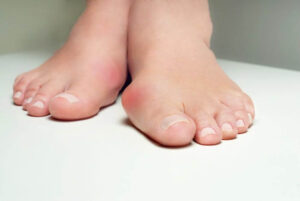 Bunions aren’t just a problem for adults — they can also affect children and teenagers. Known as Juvenile Bunions, this condition involves the misalignment of the big toe joint, which can lead to pain, discomfort, and difficulty wearing certain shoes. Early diagnosis and treatment are essential to prevent the condition from worsening as your child grows.
Bunions aren’t just a problem for adults — they can also affect children and teenagers. Known as Juvenile Bunions, this condition involves the misalignment of the big toe joint, which can lead to pain, discomfort, and difficulty wearing certain shoes. Early diagnosis and treatment are essential to prevent the condition from worsening as your child grows.
What Are Juvenile Bunions?
Juvenile bunions are bony bumps that develop at the base of the big toe. This condition occurs when the metatarsophalangeal (MTP) joint shifts out of alignment, causing the big toe to angle toward the smaller toes. Unlike adult bunions, juvenile bunions tend to develop during growth years and may worsen over time, especially if left untreated.
What Causes Juvenile Bunions?
Several factors can contribute to the development of bunions in children and teenagers:
- Genetics: A family history of bunions or foot abnormalities increases the likelihood of developing juvenile bunions.
- Foot Structure: Flat feet, loose joints, or abnormal biomechanics can place extra stress on the big toe joint.
- Improper Footwear: Shoes that are too tight, narrow, or lack proper support can exacerbate the condition.
- Medical Conditions: Certain conditions, such as arthritis or connective tissue disorders, can make children more prone to bunions.
How Do We Diagnose Juvenile Bunions?
Diagnosing juvenile bunions involves a physical examination and imaging tests:
- Physical Examination: A podiatrist will examine the foot for visible deformities, redness, or swelling around the big toe joint.
- X-rays: X-rays help determine the severity of the bunion and assess any bone misalignment or damage to surrounding structures.
How Are Juvenile Bunions Treated?
Treatment for juvenile bunions often depends on the severity of the condition:
- Non-Surgical Treatments: Orthotic inserts, proper footwear, and physical therapy can help alleviate pain and slow the progression of bunions.
- Surgical Options: If non-surgical methods are ineffective and the bunion interferes with daily activities, surgery may be recommended to correct the misalignment.
What Can My Podiatrist Do About Juvenile Bunions?
A podiatrist plays a critical role in managing juvenile bunions. At the Southwest Foot and Ankle Center, our podiatrists provide comprehensive care for children and teenagers, including:
- Custom orthotics to support proper foot alignment.
- Guidance on choosing footwear that prevents further irritation.
- Expert surgical options, if necessary, to restore normal foot function and relieve pain.
Final Thoughts
Juvenile bunions can significantly affect a child’s quality of life, but early intervention can prevent the condition from worsening. Whether your child is experiencing mild discomfort or severe pain, seeking professional care is the first step toward healthy, happy feet.
The Southwest Foot and Ankle Center specializes in treating chronic foot conditions like juvenile bunions. With advanced diagnostic tools and personalized treatment plans, we’re here to help your child walk comfortably again. Contact Southwest Foot and Ankle Center today to schedule a consultation and give your child the expert care they deserve!
Contact us
Schedule an appointment
with our podiatrist by contacting us or calling our: